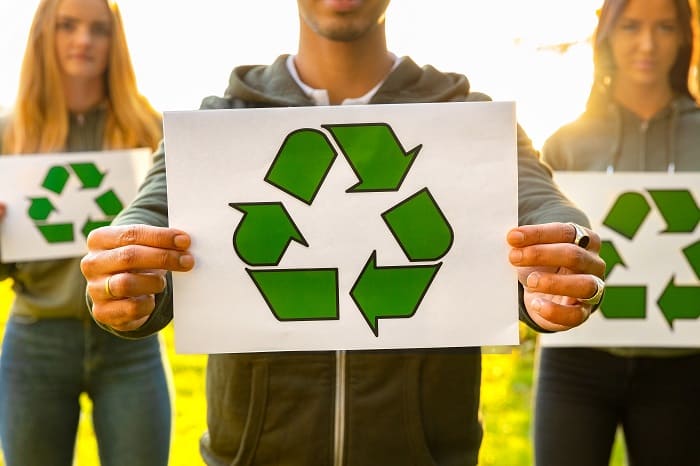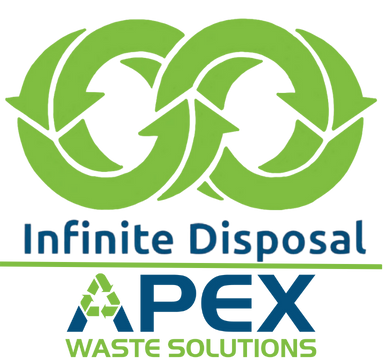
A huge part of waste management is recycling. Why should we recycle? It is a simple concept: when you transform something old into something new, it benefits the environment in a number of ways. Materials and natural resources are not wasted. Energy is saved during the manufacturing process and there is less waste going to landfills. Not to mention, it helps keep local wildlife safe. In this short guide, we want to give you the valuable information you need to make educated choices when it comes to your home and business recycling efforts.
Benefits of choosing to recycle:
- Protects the environment
- Reduces pollution
- Reduces greenhouse gases and global climate change
- Protects fragile ecosystems and wildlife
- Reduces the size of landfills
- Conserves natural resources
- Creates employment opportunities
- Saves energy
- Brings your community together
The main thing that keeps people from recycling is understanding the process. Knowing where to recycle and what to recycle is something that not everyone is familiar with. Every city has their own regulations and process for recycling, so it’s important to do your own research. When you work with Infinite Disposal for your recycling needs, we make the process very clear for you.
We will:
- Provide you with a recycling container
- Inform you of your pickup days and times
- List the items we accept
- Let you know any specifics that would prevent your items from being accepted
What to recycle
There are a few materials out there that cannot be recycled at this time. The most common items that CAN be recycled include paper, plastics, and glass.
Paper
How is paper recycled?
After paper is put into your recycling bin, it is taken to a recycling center where contaminants like plastic, glass, and trash are removed. The paper is then sorted into different grades. Once the paper is sorted, it is stored in bales until a mill is in need of it. It will then be transferred to the mill for processing.
Once paper arrives at the mill, large machines called pulpers shred the paper into small pieces. Mixed with water and chemicals, the paper is heated and breaks down into fibers. After that, the mixture is passed through a big screen to remove adhesives and other remaining contaminants. Next, the paper will be spun in a cone-shaped cylinder to clean it, and sometimes ink will also be removed. At this point, the pulp is sent through a machine that sprays it onto a conveyor belt. Water will drip through the belt’s screen, and the paper fibers will start bonding together. Heated metal rollers will dry the paper, and the paper will be put onto large rolls, which can be made into new paper products. Pretty cool, huh?
Plastic
How is plastic recycled?
First, plastic is collected in recycle bins. It is important to note that if plastic is thrown into a regular trash bin, it will end up in a landfill, and will not be recycled. Therefore, it is important to separate common waste from plastic waste.
The collected plastic waste is then taken to a recycling facility for sorting. The machines sort the plastic into different areas depending upon its properties, and what final product is being produced. Plastics are sorted are based on the type, color, or how it was made. Sorting is important because each type of plastic must be processed differently, and most recycling facilities are only capable of recycling one type of plastic.
The sorted plastic is then washed to remove impurities, like labels and adhesives. This enhances the quality of the finished product. If the non-plastic waste is not removed, it can result in a final product that has poor structural integrity.
The plastic waste is loaded into different conveyor belts that run the waste through different shredders. These shredders tear up the plastic into small pellets that increase its surface area. Smaller pellets of plastic make it easier to process, reshape, and to transport. Metal detectors or magnets are used to remove any leftover metal in the mixture.
Next, the small plastic particles are tested to determine their quality and class. The first test is to check the density. The particles are put in a large tank of water. Denser particles sink and less dense one’s float. The next test is air classification, which determines how thin or thick the particle is. The particles are dropped into a small wind tunnel. The bigger ones remain low, and the smaller ones fly higher up. Lastly, the shredded plastic is melted and extruded into pellets, which are used for future plastic product production.
Glass
How is glass recycled?
All glass collected separately is brought to a glass storage facility. It is then bulked up and transported to a glass treatment plant. The glass goes through a pre-treatment process which removes any paper or plastic using blown air. Any metal objects are removed with magnets. Next, it is sorted by color and washed to remove any further impurities.
Then the glass is crushed, melted, and molded into new products such as bottles and jars. A highly versatile material with almost limitless applications, we think it makes complete sense to recover as much glass as practically possible through recycling!
Glass does not degrade through the recycling process so it can be recycled again and again. This is one of the most efficient forms of recycling of any type of commercial waste, with almost 100% recovery of the original material in an extremely clean and pure form, with fantastic environmental benefits.
We hope this article gives you some insight into why it’s important to recycle and how it’s done! Infinite Disposal is your number one recycling service in Colorado Springs. We are the experts and will make sure your recyclables are taken care of appropriately. Please contact us if you have any recycling questions!

0 Comments